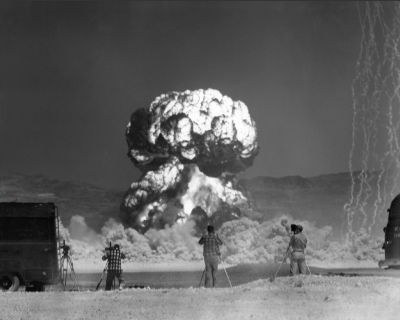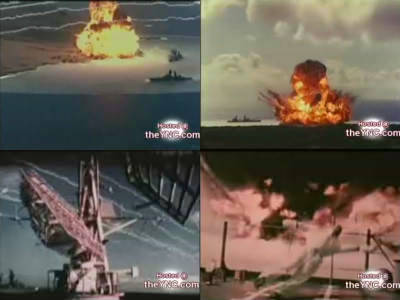Photographers who recorded the atomic hydrogen bomb test of the US military without knowing that it was a life, and were buried in the darkness of history

There seems to be a group of cameramen who recorded the atomic hydrogen bomb test carried out by the US military from 1945 to 1962 with images and photographs secretly behind.
While many of the scientists who were involved in the development of atomic hydrogen bomb during the Cold War gained fame, photographers who recorded it at the risk of death never go out to the stage stage and many died while preserving confidentiality That it was. While information is being released over half a century, George Yoshitake, one of the few survivors of that secret shooting team, said that time.
Details are as below.Capturing the Atom Bomb on Film - Audio & amp; Photos - NYTimes.com
Secret Corps of Filmmakers Documented Nuclear Bomb Tests - NYTimes.com
In addition to the photographers who photographed the atomic hydrogen bomb experiments, the team of 250 people, including directors and producers, consisted of those who strictly checked their identity and vowed to keep confidentiality, and they are headquartered in Hollywood. famousSunset StripA studio of 100 thousand square feet (9290 square meters) close to it was originally a defense base of the US Air Force which manages the radar of the nearby summit in 1941 during the Second World WarLookout Mountain Airforce StationThe video production unit founded in 1947 was called "Lookout Mountain Laboratory". "It seems that neighbors thought suspiciously because the light was on over the night," ex-photographer George Yoshitake (82) said.
About 6,500 recorded images were produced in this studio for 22 years, and later the latest equipment, photography technology, projection technology etc at the time were to be used for Hollywood movies were tried. Photographing crews did not know that it would be a life-saving job, and a helipad was also set up with a studioNevadaWe sent the days to busy and visit the experiment sites.

According to Mr. Yoshitake, photographers who went and photographers who got in the shoot wore all the badges that showed the exposure dose, and according to the distance from the experiment site they said that they had submitted the badge once a week about. "We were prepared for things such as being informed about the dangers of the atomic bombings, for example that the hair might fall out, but no one thought that it would die," Yoshitake said I recall. "A lot of friends' photographers also passed away, I am still pretty healthy and I could live until this year, so I can say it is one of the few lucky survivors."

Michal Czerwonka for The New York Times
The image is a book published in 2006 "How To Photograph an Atomic BombFrom. This was taken in 1953.

Mr. Peter Kuran, author of "How To Photograph an Atomic Bomb", is the creator of special effects movies that are active in Hollywood. In 1997 when the disclosure of information was in progress, we planned and photographed the events that gathered survivors of the A-bomb experiment shooting team and seems to be very impressed by the high skill and courage of the A-bomb photographers.

Leah Nash for The New York Times
A few hundredths of a second after this picture was taken, the vehicle stopped under a fireball has disappeared without a trace.

John Kelly Sergeant Sergeant, 1958, shooting at the experimental site in Nevada.

How close to the hypocenter is depends on the type of bomb, and photographers were arranged based on a strict plan. In the Pacific Ocean Bomb Experiment, we shoot from a distance of 20 miles (about 32 km), a Nebada A-bomb experiment with a distance of 5 to 6 (8 to 10 km) miles, and occasionally only 2 mile (3.2 km) from the hypocenter Some photographers have come close to the distance. According to Mr. Yoshitake, Nevada saw the shock waves coming up as the soil flew up, and he was able to feel fever from the explosion in 10 to 15 seconds.
A picture of the atomic bomb just after the explosion started with a special camera with a very fast shutter. It was taken at a distance of 2 miles from the hypocenter in 1952.

Pictures taken at the experiment site in Nevada in 1955. The wavy thin smoke rising to the right was smoked to observe how the shock wave in the atmosphere was transmitted.

"Although there may be many people who have seen small explosions in the video, it is hard to believe that witnessing the power of atomic bombs and hydrogen bombs with this eye is the first experience in the Pacific Ocean. However, I still remember the eerie purple shine that dyed the early morning sky after the explosion.The overwhelming power that was shown was terrible, "Yoshitake says.
Photographed in South Pacific in 1956Hydrogen bomb. The hydrogen bomb is said to be 1000 times stronger than the atomic bomb.

The atomic bomb, which was filmed in 1958, is about a half of the atomic bomb dropped on Hiroshima "small bomb".

The photographs and images were used as scientists to analyze the nature and power of nuclear weapons, and there were cases that were screened for government officials. After 1963 all the nuclear tests began to be carried out in the basement, the photography team was dissolved, then in 1997 under the Clinton administrationHazel R. O'LearyEnergy Secretary promised to release confidential designation of these recorded images, information disclosure has been advanced.
VIPs who visit atomic bomb experiments in South Pacific in 1951.

After the transition to the Bush administration and the fear of nuclear weapons spread among the people after the simultaneous multiple terrorist attacks, the movement of information disclosure ceased in 2001, but there are 6,500 recorded images of nuclear tests Approximately 100 of them are published by the Energy Agency and can be viewed from the following links.
DOE - NNSA / NSO - Historical Test Films

"At the time of the filming, it was just a matter of work and I did not think deeply, but in Japan there are also relatives who died in Hiroshima and Nagasaki, then visited Japan and witnessed the horror of the atomic bomb, Mr. Yoshitake said that it should not occur in this world absolutely, "Mr. Yoshitake evaluated the efforts for publishing, restoration and conservation of these images as a sound movement, and by publicizing the information, the public's It seems that understanding has deepened.
A city in Nagasaki shot in 1945.

Yoshitake said that even now that the Cold War ended, Yoshitake felt doubts about the necessity of developed countries to keep enormous numbers of nuclear weapons, said "Do you need such a lot of bombs? It is terribly horrible" It is.
Related Posts:
in Note, Posted by darkhorse_log







